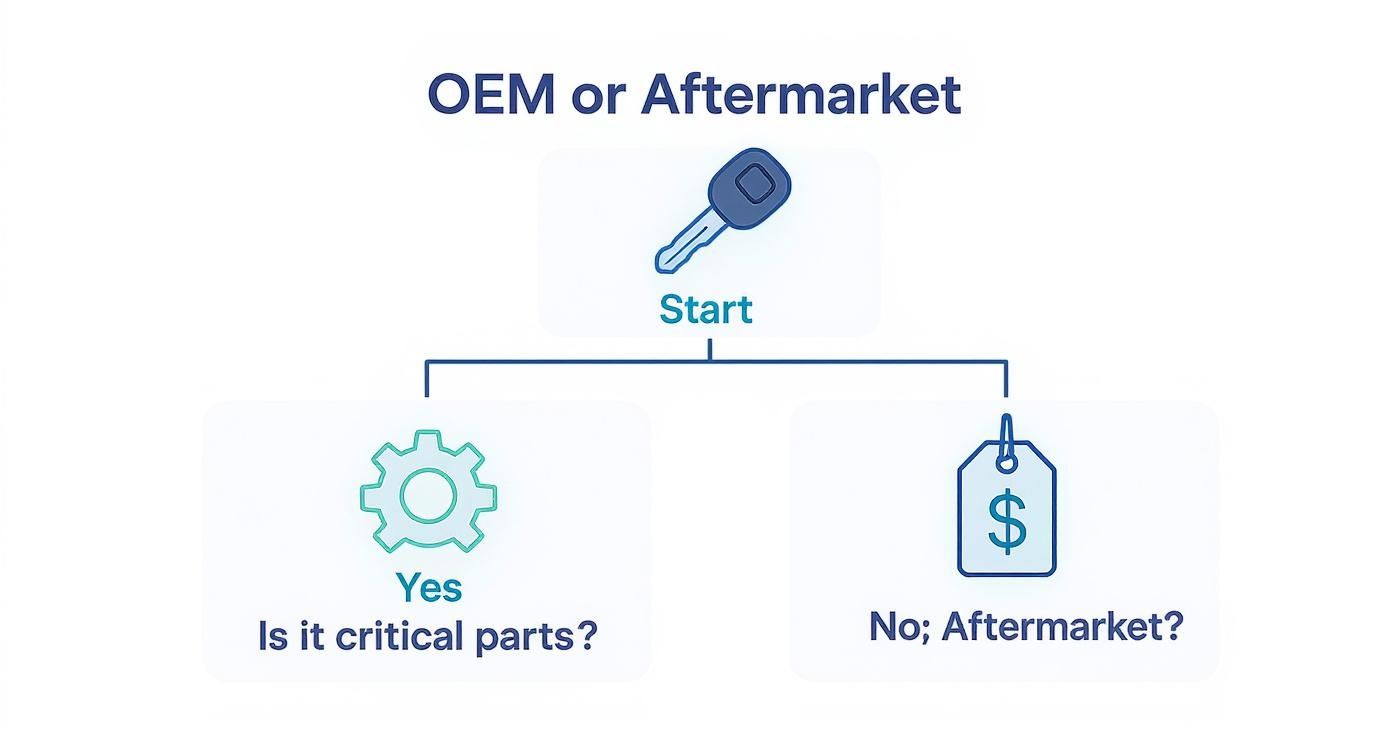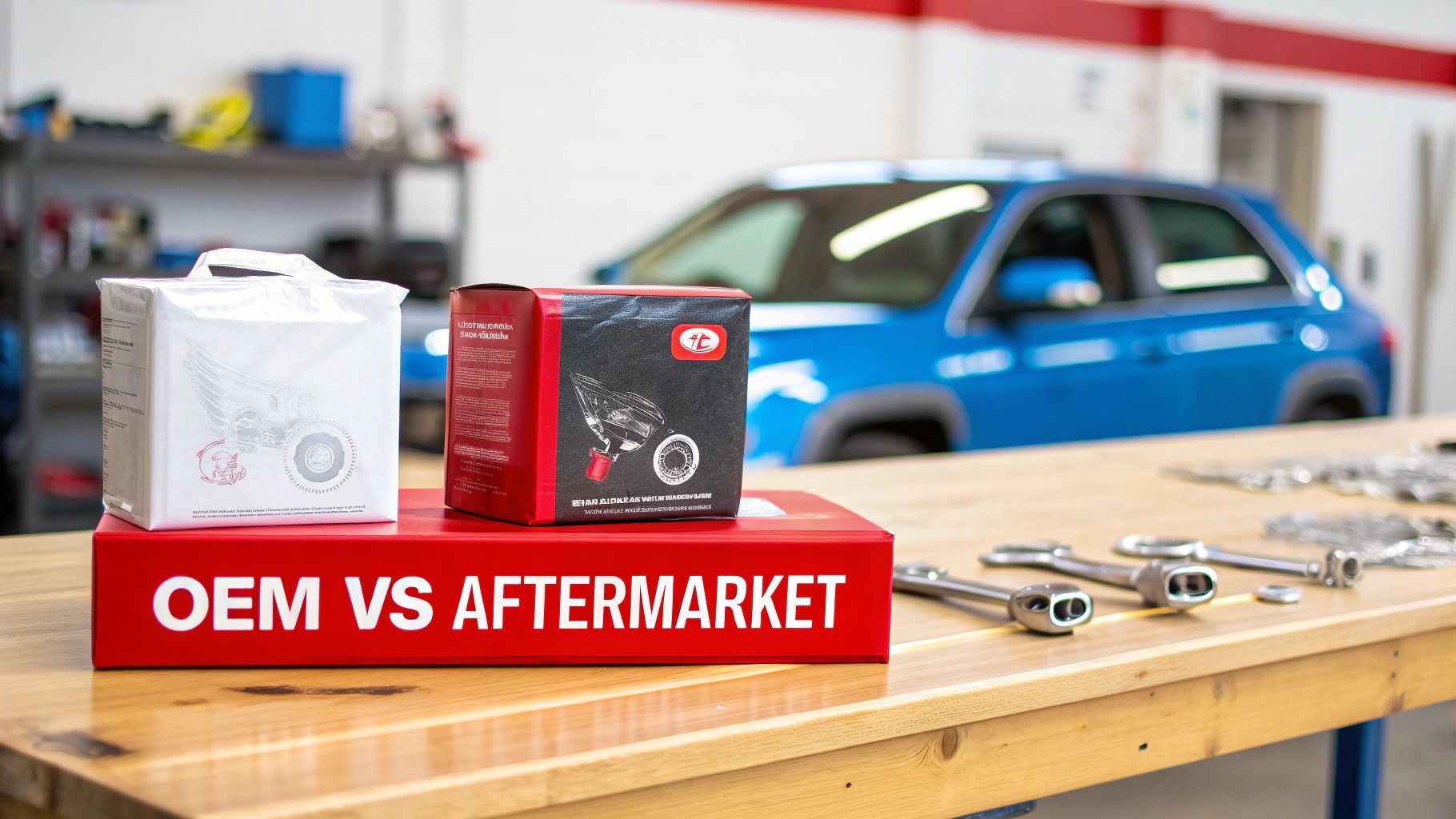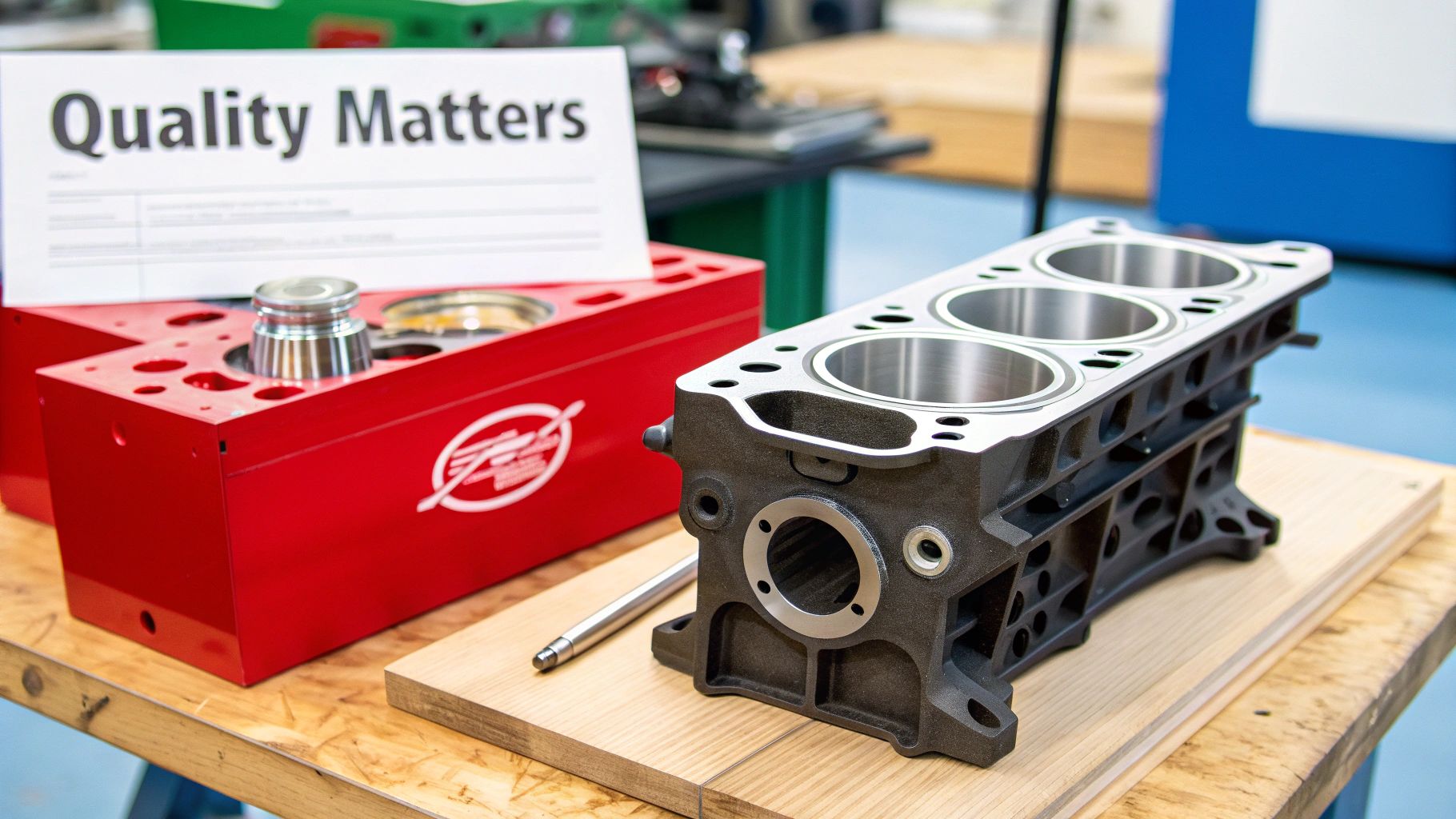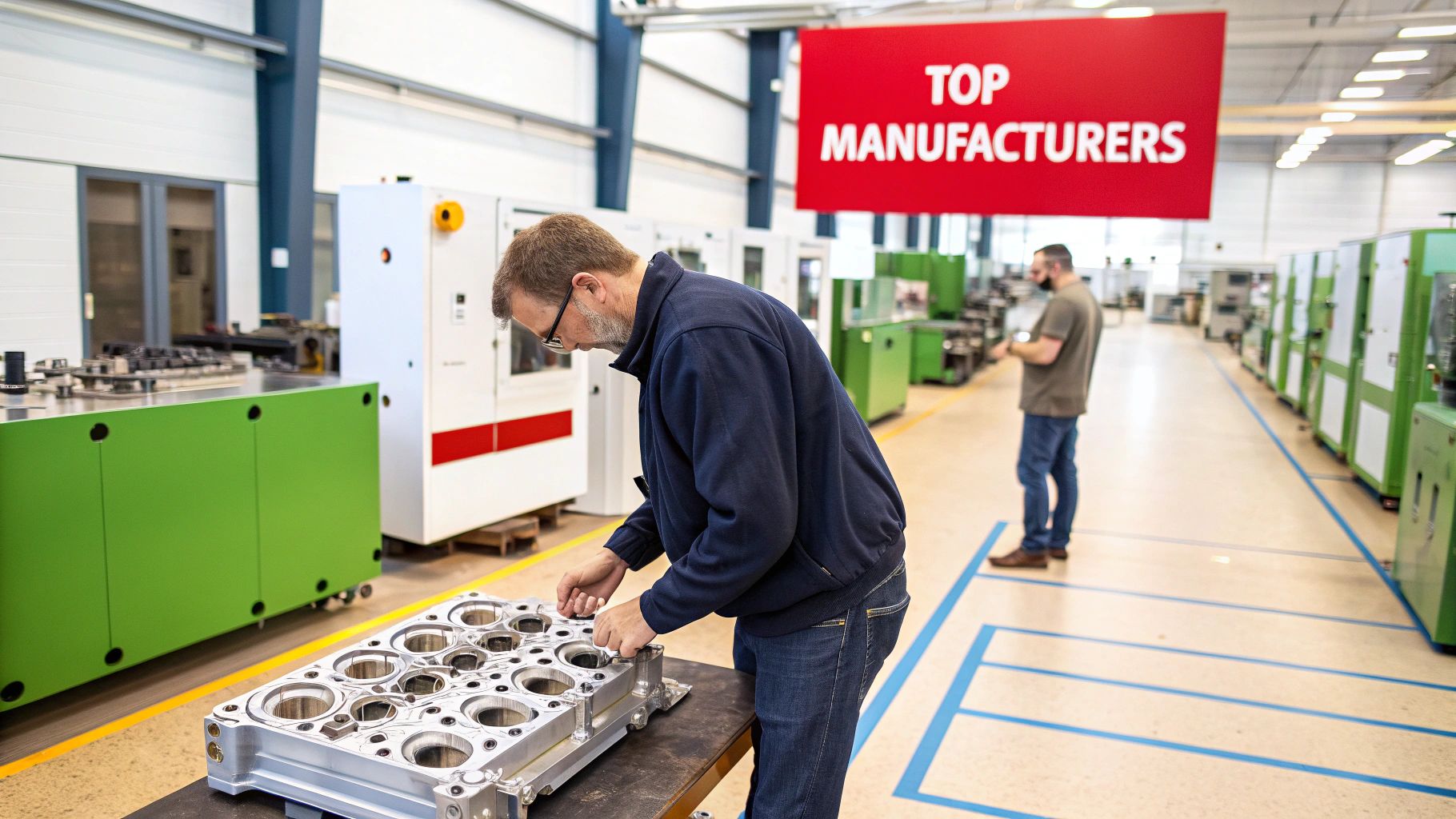When you start looking for the best auto parts brands, the first big decision you'll face has nothing to do with a specific brand name. It's about a fundamental choice between two types of parts: OEM and aftermarket.
Think of it this way: OEM parts are identical to what the factory installed in your car, promising a perfect fit and known quality. Aftermarket parts, on the other hand, open up a world of different options, often at a much friendlier price.
OEM vs Aftermarket: What Is the Right Choice?
Picking between OEM (Original Equipment Manufacturer) and aftermarket parts is a bit like choosing between a big-name brand and the store's own brand at the supermarket. Both can do the job, but they differ in price, quality, and the sheer number of choices you have.
OEM parts are made by the same company that supplied the originals for your vehicle right off the assembly line. They're the "factory-certified" components. You can count on a perfect fit because they're built to the exact specs your car's engineers designed. This is precisely why they're the default choice for critical repairs where there’s zero room for error.
Aftermarket parts come from a wide range of companies that aren't the original manufacturer. This competition creates a huge market with a ton of selection, often at prices that are easier on your wallet. Some aftermarket companies even take pride in engineering their parts to be better than the original, fixing known weak points in the factory design.
Deciding What Is Right for Your Repair
So, which one is right for you? It all boils down to the specific part you're replacing.
If you’re dealing with a mission-critical component—say, a timing belt or a water pump—sticking with an OEM part (or a premium OEM-equivalent) buys you invaluable peace of mind. A failure in one of those parts could spell disaster for your engine, so a higher upfront cost is a smart investment in reliability.
A good rule of thumb is this: if a part failing could put you in danger or lead to a much bigger, more expensive repair later, don't skimp. Prioritize quality and a perfect fit above all else.
But what about a cosmetic part, like a side mirror or an interior door handle? In that case, a well-regarded aftermarket brand can deliver fantastic value without compromising how the car works. You get to save some cash on a component that doesn’t affect your vehicle’s core safety or performance.
To help you decide at a glance, here’s a quick comparison of the two main types of auto parts.
Quick Guide to Auto Part Types
| Part Type | Key Characteristic | Best For | Price Point |
|---|---|---|---|
| OEM | Made by the original vehicle manufacturer. Guaranteed fit and quality. | Critical components (e.g., engine, transmission, safety systems). | Higher |
| Aftermarket | Made by third-party companies. Wide variety and competitive pricing. | Non-critical parts (e.g., cosmetic items, lighting, some accessories). | Lower to Mid-Range |
Ultimately, choosing the right type of part sets the foundation for a successful repair. For a deeper dive into this topic, you can learn more about the pros and cons of OEM vs aftermarket parts.
This simple decision tree helps visualize when to choose OEM or a high-quality aftermarket alternative.

As you can see, the single most important factor is just how critical the part is to your vehicle’s safe and reliable operation.
Understanding the Global Auto Parts Industry

Before you can pick the best auto parts brands, it helps to pull back the curtain on the massive industry that makes them. This isn't just a scattered collection of local garages and machine shops. The global auto parts market is an absolute powerhouse of engineering, manufacturing, and logistics, with a handful of major players calling the shots.
A good way to think about it is to compare it to the tech world. Just like a few big names design the microchips inside almost every computer, a select group of automotive giants engineers the critical systems for most cars on the road today. Companies like Bosch, Denso, and Magna aren't just stamping out metal parts; they are innovation hubs pouring billions into research and development.
That kind of investment is what allows them to lead the way on everything from sophisticated fuel injection systems to the complex sensors that run modern driver-assist features. When you buy from one of these top-tier suppliers, you’re often getting the very same quality and technology that car manufacturers trust to install on the assembly line.
The Scale of the Industry
The sheer size of this market is hard to wrap your head around. The global auto parts manufacturing sector is a sprawling industry projected to be worth an estimated $555.7 billion by 2025. And while thousands of suppliers exist, the top 10 companies rake in nearly half of all that revenue.
Leaders like Bosch and Denso hold huge portions of the global market all by themselves. You can dive deeper into the auto parts manufacturing market and its key players to see the numbers.
This concentration means that a few key companies effectively set the benchmarks for quality, reliability, and new technology for everyone else. Their influence is felt all the way down the supply chain, shaping the parts available to you, whether you’re buying from the dealer or your local parts store.
When a brand invests billions in R&D, it’s not just for show. That investment translates directly into parts with better materials, more precise engineering, and longer lifespans—benefits that every car owner can appreciate.
Regional Strengths and Specializations
It’s also helpful to know that different parts of the world have earned reputations for excellence in specific areas. Understanding these regional strengths can point you toward the best brands for the job.
-
Europe: This is the home of precision engineering, especially out of Germany. European brands are often the gold standard for high-performance engine components, top-tier braking systems, and complex electronics.
-
Asia-Pacific: A true powerhouse in automotive electronics, batteries, and hyper-efficient manufacturing processes. Brands from Japan and South Korea, in particular, are legendary for their reliability and advanced sensor technology.
-
North America: Has a well-earned reputation for building brawny, durable components for trucks and larger vehicles. This includes heavy-duty powertrain parts and rugged chassis components designed to take a beating.
By seeing the bigger picture, you can start to connect the dots between a brand's global reputation and the real-world performance you can expect from their parts. It’s not just a name on a box—it’s a reflection of decades of focused engineering and manufacturing expertise.
What Separates Great Brands from Good Ones
Walking down the aisle of an auto parts store can be overwhelming. You see two brake rotors that look virtually identical, but one costs twice as much as the other. What gives? So, what really separates a top-tier brand from a merely "good enough" one? It boils down to a few critical factors that have nothing to do with a shiny box or clever marketing.
Think of your vehicle as a complex system. You wouldn't use cheap, untested wiring in your house, right? The same logic applies to the critical components keeping you safe on the road. The best brands prove their worth through a deep commitment to superior materials, manufacturing precision that borders on obsessive, and certifications that actually mean something. These are the things that deliver safety, performance, and peace of mind.
The Science of Superior Materials
The first and most important sign of a great brand is its choice of raw materials. We're not just talking about using metal instead of plastic; this is about a deep understanding of material science. For example, a premium control arm is often made from forged steel, a process that makes it incredibly strong and resilient. A budget alternative might use cast aluminum—it’s lighter, sure, but can be more brittle under the extreme forces of a pothole or hard turn.
A top brand invests in the right material for the job, one that can handle intense heat, constant vibration, and years of abuse. This focus on better materials isn't a cost-cutting measure; it's a direct investment in the part's longevity and, ultimately, your safety.
The difference between a good part and a great one often lies in the details you can't see. It's the specific grade of steel, the heat treatment process, or the polymer blend that allows a part to function flawlessly for 100,000 miles instead of failing after 10,000.
Precision Fitment and Industry Certifications
Even the best materials on earth are worthless if the part doesn't fit. This is where manufacturing precision takes center stage. The best auto parts brands operate with incredibly tight tolerances, ensuring their products install perfectly and work exactly as the original vehicle engineers designed them to. A part that’s off by even a single millimeter can cause annoying vibrations, accelerated wear on other components, or even catastrophic failure.
How do you know a brand is serious about this? They prove it with rigorous industry certifications. One of the most respected in the automotive world is ISO/TS 16949. This isn't just a simple quality check; it’s a grueling audit of the entire manufacturing process, from how they source raw materials to the final inspection before boxing. A brand holding this certification has demonstrated its ability to consistently produce parts that meet the demanding specs of the world’s biggest automakers.
To help you cut through the marketing noise and evaluate any brand you're considering, this simple checklist breaks down what really matters.
Brand Evaluation Checklist
| Evaluation Criteria | What to Look For | Why It Matters |
|---|---|---|
| Material Quality | Specifics like "forged steel," "heat-treated alloys," or "OEM-grade polymers." | Superior materials directly translate to a longer lifespan and better performance under stress. |
| Guaranteed Fitment | Promises of "direct-fit" or "OEM-spec" design, backed by vehicle compatibility checkers. | Ensures a hassle-free installation and prevents issues caused by poor alignment or gaps. |
| Certifications | Look for mentions of ISO/TS 16949, CAPA (for cosmetic parts), or other recognized standards. | Provides third-party validation of a brand's quality control and manufacturing processes. |
| Warranty Terms | A clear, long-term warranty (like a lifetime warranty on key components) shows confidence. | Protects your investment and indicates the brand stands behind its product's durability. |
Keep these four pillars in mind, and you'll be well-equipped to choose parts that don't just fit but are built to last.
A Look at Top-Tier Auto Part Manufacturers

Now that we have a solid checklist for what makes a quality part, let's put it into practice and look at the titans of the industry. When you pop the hood, you’re often looking at a collection of components from just a handful of global powerhouses. These are the manufacturers automakers turn to time and again because their names are practically synonymous with reliability and forward-thinking engineering.
Brands like Bosch, Denso, and Continental don't just make aftermarket replacements; they are woven into the very fabric of new vehicle design. Think of them as the master chefs who supply the world’s best restaurants with their most crucial ingredients. The car company might design the final "dish," but these suppliers are the ones perfecting the core components that make it all come together flawlessly.
This tight-knit relationship with automakers gives them a massive leg up. They have an insider's understanding of vehicle systems, which lets them engineer parts that don’t just meet the original specs—they often blow right past them.
The Powerhouses of the Parts World
A few names consistently dominate the global stage, thanks to their sheer scale and an unyielding commitment to innovation. If you look at the top auto parts suppliers by revenue, you’ll see Bosch, Denso, Continental, ZF, and Magna consistently at the top. We're talking about staggering numbers here, with Bosch pulling in around $45.4 billion and Denso not far behind at $41.7 billion.
These aren't just parts factories; they're R&D hubs. Bosch, for example, pours over $7 billion into research and development every single year.
That colossal investment is what backs up their reputation. It translates directly into the quality markers we’ve been talking about: better materials, precision manufacturing, and performance that’s been tested to the breaking point. They’re the ones pushing the envelope on everything from advanced driver-assistance systems (ADAS) to the next wave of electric vehicle technology.
The connection is simple: a multi-billion-dollar R&D budget is a direct investment in reliability. When you choose one of these top-tier brands, you are benefiting from thousands of hours of engineering and testing designed to create a part that will perform flawlessly for years to come.
Why Their Reputation Is Earned
These manufacturers didn't just stumble into leadership positions. Their global footprint and long history are built on a foundation of trust that they’ve earned over decades of consistent performance.
- Bosch (Germany): A true legend in fuel injection, engine management, and life-saving safety systems like ABS and stability control.
- Denso (Japan): The undisputed world leader in thermal systems—think radiators and A/C compressors—as well as powertrain control modules and spark plugs.
- Continental (Germany): Famous for its expertise in tires, but also a giant in advanced braking systems and sophisticated interior electronics.
When you choose a part from one of these industry leaders, you’re getting a component built with the same obsessive quality control demanded by the world's most prestigious car brands. It’s that unwavering commitment that makes them the benchmark for any serious repair or upgrade.
How to Navigate Aftermarket and Retail Brands

So, you know that brands like Denso and Bosch are the ones actually making top-tier components. But here's the thing: you can't just walk up to their factory door and buy a fuel pump. That's where the aftermarket comes in—a massive, bustling world of retailers and distributors all competing for your business.
This is the world where most of us, from seasoned mechanics to weekend DIYers, actually buy our parts. Understanding how it works is crucial.
Think of it like a grocery store. The store itself, say an AutoZone or a local shop, doesn't actually produce the goods on its shelves. Instead, it acts as a curator, deciding which brands to stock. A good retailer fills its aisles with quality options from the best auto parts brands, making it easy for you to find a reliable part.
The real challenge? While a handful of big names dominate manufacturing, the retail side of things is a different beast entirely. It’s incredibly fragmented, with thousands of sellers all trying to get your attention, which means quality and service can be all over the map.
What Makes a Retailer Trustworthy?
A great auto parts retailer does more than just move boxes. They build trust. The first thing I look for is their inventory and supply chain. Do they have the part I need in stock? Can they get it to me fast? Nothing is worse than having your car stuck on jack stands for days, so a retailer with a solid logistics game is a huge plus.
Then there's customer support. Sooner or later, you'll have a question about whether a part really fits your specific trim level, or you’ll hit a snag during installation. That's when knowledgeable, easy-to-reach support becomes priceless. The best retailers are your partners in the repair, not just a checkout counter.
Finally, check their policies. A solid warranty and a no-nonsense return process tell you a lot. It shows the retailer stands behind what they sell because they’re confident in the quality of their parts.
Understanding the Retail Market Landscape
Unlike the big, consolidated world of manufacturing, the auto parts retail space is wide open. Believe it or not, the top seven auto parts retailers in the entire world only make up about 16% of the market. Even the biggest player in the U.S., AutoZone, holds just 4% of the global market. You can dig deeper into the auto parts retail market and its fragmentation to see just how spread out it is.
This fragmentation gives you tons of choice, but it also puts the burden on you to do your homework. A retailer’s reputation for stocking quality parts from respected manufacturers is just as important as the brand name on the box itself.
Choosing where you buy is a make-or-break step in getting a part that fits right and goes the distance. A great retailer is more than a store; they're your gateway to quality components and the support you need to get the job done right.
To help you narrow down your choices, check out our guide on finding the best aftermarket auto parts on the market right now. When you focus on retailers with a proven track record, you can navigate the aftermarket like a pro.
Putting It All Together: Choosing the Right Parts for Your Ride
So, what have we learned? Choosing the right auto parts brand isn't about finding a one-size-fits-all answer. It's about making a savvy decision based on your specific needs, your vehicle, and your budget.
Think of it as a balancing act. For a mission-critical part like a fuel pump that keeps your engine running, investing in a premium, OEM-equivalent brand is a no-brainer. But for something like a broken interior door handle? A trusted aftermarket brand delivers fantastic value without breaking the bank.
This isn't about guesswork anymore. You now have the tools to look at a part and see more than just a price tag. You know what to look for in materials, why certifications are more than just stickers, and how a solid warranty protects you down the road.
At the end of the day, this is all about protecting your car, your wallet, and most importantly, your safety. Following these principles means you're no longer just a car owner; you're an informed consumer who makes smart repairs.
When you're looking at aftermarket options, always put safety first. This is non-negotiable for components like seat belts and their accessories. You can learn more from this definitive guide on seat belt extender legality and safety.
Of course, knowing what to buy is only half the battle. You also need to know where to find it. Sourcing quality components from the best online auto parts retailer makes the entire process smoother and more reliable.
Frequently Asked Questions
Diving into the world of auto parts can feel a bit overwhelming, and it's natural to have questions. Here are some quick, straightforward answers to the ones we hear most often, so you can feel confident you're picking the right brand for your car.
Are Expensive Auto Parts Brands Always Better?
Not always. It’s a common assumption that a higher price tag equals higher quality, but it's more nuanced than that. For critical components that keep your car running safely—think brake calipers or an engine sensor—investing in a premium brand known for its engineering is absolutely worth it.
But what about a cosmetic part, like an interior door handle on a daily driver? A good aftermarket brand often provides the perfect mix of quality and value. The real trick is to match the part's quality to its importance. You don't need to overspend on non-critical parts, but you should never, ever skimp on the components that affect your car's safety and performance.
What Is the Difference Between OEM and OES Parts?
This is a big one, and it's where you can save some serious money. An OEM (Original Equipment Manufacturer) part is what you'd get from the dealer. It comes in a box with the automaker's logo on it, like Ford or Honda.
An OES (Original Equipment Supplier) part is made by the very same company that manufactured the original part for the automaker. The only difference is that it's sold in the supplier's own box (say, from Bosch or Denso) instead of the car company's. You get the exact same quality and fitment as the OEM part, but without paying extra for the vehicle's brand name.
Think of it like this: an OES part is the brand-name cereal without the cartoon character on the box. You're getting the same good stuff inside, just without the premium logo tax. It’s one of the smartest ways to get top-tier parts without breaking the bank.
How Important Is a Warranty When Choosing an Auto Parts Brand?
A warranty is more than just a piece of paper; it's a direct reflection of a manufacturer's faith in its own product. It’s your safety net if a part fails sooner than it should.
For parts that are both expensive and a pain to replace—like an alternator, a water pump, or a modern rearview camera—a solid warranty isn't just nice to have, it's essential. It protects you from having to pay for the same job twice. Brands that stand behind their products with multi-year or even lifetime warranties are showing you they're committed to quality.
- Critical Components: A long warranty (3+ years or lifetime) should be a non-negotiable.
- Minor Parts: A warranty is still a good sign, but it might not be the single biggest factor in your decision.
Just be sure to read the fine print. Does the warranty cover only the part, or does it include the labor costs to replace it? The labor can often be the most expensive part of the repair, so knowing exactly what's covered is key. The best brands are upfront about their warranty terms.
At T1A Auto, our goal is to take the guesswork out of finding reliable replacement parts. We focus on premium aftermarket components that often feature upgraded materials and always have a guaranteed fit. We back our metal parts with a lifetime warranty, so you can tackle your repair with complete confidence. Find the right part for your vehicle today at t1aauto.com.



